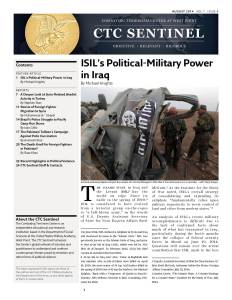Cover Story Overview
ISIL’s Political-Military Power in Iraq
By Michael Knights
The Islamic State in Iraq and the Levant (ISIL) has the world on edge. Since its nadir in the spring of 2010, ISIL is considered to have evolved from a terrorist group on-the-ropes to “a full-blown army,” in the words of U.S. Deputy Assistant Secretary of State for Near Eastern Affairs Brett McGurk. An analysis of ISIL’s recent military accomplishments is difficult due to the lack of confirmed facts about much of what has transpired in Iraq, particularly during the hectic months since the collapse of federal security forces in Mosul on June 10, 2014. Nevertheless, using a range of case studies from the Iraqi side of ISIL’s area of operations, this article explores what is currently known about the movement from a military standpoint. If ISIL is an army, what kind of army is it and what are its weaknesses? This article finds that ISIL is a military power mostly because of the weakness and unpreparedness of its enemies. Lengthy shaping of the battlefield, surprise and mobility made its recent successes possible, but all these factors are diminishing. As a defensive force, ISIL may struggle to hold terrain if it is attacked simultaneously at multiple points or if its auxiliary allies begin to defect.
 Skip to content
Skip to content

